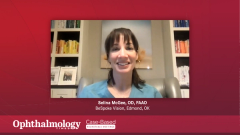
Impressions and Key Takeaways From Patient Case #2
Selina McGee, OD, FAAO, emphasizes the significance of a multifactorial treatment approach for dry eye, especially in patients concurrently using other eye drops or contact lenses, and advocates for ocular sparing therapies when needed.
Selina McGee, OD, FAAO: Key takeaways and thoughts on case 2 are, again, like our case 1, making sure that we properly diagnose with each and every diagnosis. I think sometimes, historically, because we didn't have a lot of choices, we did the best that we could and we would treat 1 part of the disease. But now we have multiple ways to treat dry eye disease. And remember, this is a multifactorial disease. So if we're not treating it in a multifactorial way and addressing each of those pieces, we're going to have gaps in the way the patient is therapeutically managed. Remember that dry disease affects every facet of our practice and our patients come to us because they want to see.
Whether we're doing refractions, contact lens fits, refractive surgery, refractive cataract surgery, aesthetic surgery, like a blepharoplasty, etc, all of those pieces, we must optimize the ocular surface. We have to have in place a lid and lash strategy with our patients having Demodex blepharitis, with our patients doing things to the lids and the lashes like serums, like eyelash extensions, all of those things play a role in how our patient's ocular surface is functioning day to day.
Sometimes, our patients are sabotaging their ocular health and our best efforts. If we don't ask great questions and if we don't have a lid and lash strategy in place, it doesn't have to be complicated. It just has to be intentional. And then the second question that I want you to walk away with is I want you to figure out and build your protocol on ocular surface optimization strategy. There are those places where you need the ocular surface to be managed in a quick way, whether it's cataract surgery, refractions, or contact lens patients.
Let's talk about contact lenses for a moment. Our contact lens dropout rate hasn't changed in the past 20 years. And I think that's interesting because we have amazing technology, yet the dropout rate is the same. What should that tell us? That should tell us that it's not the contact lens, it’s the ocular surface. And if we optimize that, we'll have better success with our contact lens patients. So we have to have that strategy in place and thinking differently in managing that and utilizing the therapeutics that we have, especially places where we can spare the ocular surface and use a nose spray for the body to produce its own tears. Remember, the way that that works is we're addressing the lacrimal functional unit. When you stimulate the lacrimal functional unit, you get aqueous because of the lacrimal glands and their accessory glands being stimulated, the meibomian glands express and the goblet cells degranulate. You’re hitting all pieces of the lacrimal functional unit. You can’t just pick and choose when you’re doing neurostimulation and whether that’s chemical or whether that’s mechanical. You’re addressing both those places and having the patient’s body make its own tears. So [these are] things to think about when you're looking at your ocular surface optimization strategy.
And then also knowing what your dry eye disease treatment algorithm is, what will you do when you see a patient with stage 1? I think it's great to talk about ocular nutrition and making sure they have a good ω-3 on board with the correct ratio of EPA [eicosapentaenoic acid] to DHA [docosahexaenoic acid]. I like the ingredient of GLA [gamma-linolenic acid] to help that arachidonic acid pathway in a different way. Talking to our patients about managing their lids and lashes, making sure we have the patient look down. So that's some stage 1 wellness things. And what are we going to do for our stage 2 patient, stage 3, stage 4?
There's different treatment algorithms that we can lean on whether that's the ASCARS algorithm and looking at pushing on the lids, pulling on the lids, looking at vital dye, making sure that things are good there. So look, lift, push, pull and stain before the patient goes to surgery. You can certainly utilize the TFOS DEWS II report and look at their treatment algorithm. There are ways to do that and then you can customize it based on the patient. I think it's just really good for us to have these strategies in place, build your team around you so they understand these strategies as well. So then you can utilize the tools in the lane to give to your patients. They have the best outcome possible. And at the end of the day, they’re going to have the best vision possible.
Thank you for joining us in watching this Ophthalmology Times® presentation. We hope you found this presentation to be valuable and that you took away some pearls that you can immediately implement in your clinics tomorrow. And again, thank you for joining us.
Transcript is AI-generated and edited for clarity and readability.
Newsletter
Don’t miss out—get Ophthalmology Times updates on the latest clinical advancements and expert interviews, straight to your inbox.
















































